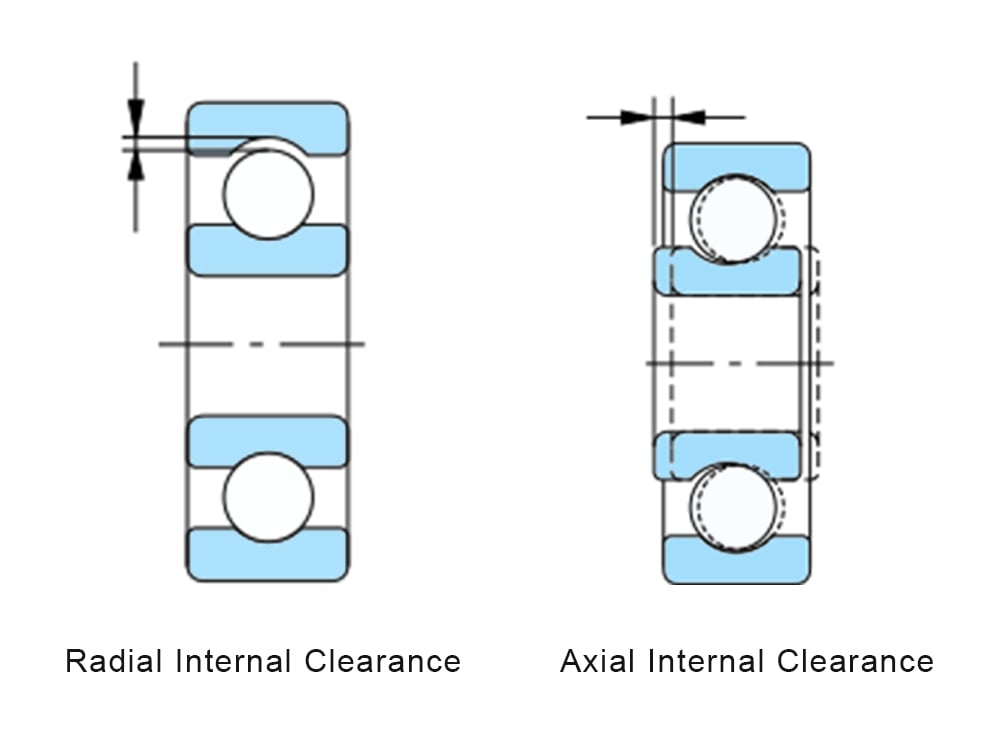Understanding the Importance of Bearing Clearance
Bearing clearances, whether in ball bearings or roller bearings, play a crucial role in the intricate world of precision engineering and machinery. Ensuring the right clearance is not only paramount for optimal machinery performance and preventing bearing failure but also for its longevity. Delve deeper into this concept as we explore the importance of bearing clearance and its profound impact on the functioning of machines.
What is Bearing Clearance?
Bearing clearance is a pivotal and fundamental concept in the intricate world of bearings, deeply embedded within the principles of precision engineering. At its core, bearing clearance is the measured space or gap between the rolling elements, be they balls or rollers, and the inner and outer raceways of a bearing.
To better delineate and standardize these clearances, the industry has classified them into five primary clearance classes, each catering to distinct operational needs and bearing designs. See Table 1.
Table 1 Clearance Class, Clearance Level and Applications & Features
|
Clearance Class |
Clearance Level |
Typical Applications & Characteristics |
|
C1 |
Less than standard |
Ideal for noise-sensitive applications; stable operating conditions |
|
C2 |
Slightly below standard |
Suited for high-speed applications requiring minimal play |
|
C3 |
Above standard |
Best for conditions with temperature fluctuations or faster thermal expansion |
|
C4 |
More than C3 |
Used in high-speed scenarios with potential high temperatures; accommodates significant thermal expansion |
|
C5 |
Highest among primary classes |
Perfect for extreme conditions with consistently high temperatures and maximum bearing play |
In terms of ball bearing internal clearance, the following picture shows ball bearing clearances for radial and axial directions. These bearing clearances significantly affect bearing radial and axial loads, particularly in terms of how the bearing will distribute and manage those loads.

Fig 1 Bearing Clearance
Maintaining the Oil Wedge
The Essence of Bearing Clearance in Oil Wedge Preservation
Bearing clearances are vital not just for smooth rotation but also for maintaining the optimal oil wedge, a protective lubrication layer between the rolling elements and bearing raceways. This layer reduces bearing friction, wear, and ensures efficient force transmission.
Challenges in Preserving the Oil Wedge
Maintaining this oil wedge's balance is no simple feat. Numerous factors can jeopardize its integrity:
- Excess Heat: Elevated temperatures can cause lubricants to lose their viscosity, thinning them out and risking direct metal-to-metal contact.
- Machining Errors: Inaccuracies during the manufacturing process can lead to uneven surfaces or misaligned components, disrupting the uniform distribution of the lubricant.
Bearing Clearances & Engine Performance
Optimal clearances ensure the formation of the ideal oil wedge, preventing metal-to-metal contact. This translates to reduced wear, maximized power output, and optimal fuel efficiency. Conversely, improper clearances can compromise engine performance and longevity.
Deciphering the Tolerance Theories
In the intricate world of bearings, the debate between opting for tight versus loose clearances remains a topic of extensive discussion. Let's delve deeper into the guiding theories behind these choices.
The Logic Behind Clearances
- Tight Clearances: Advocates emphasize benefits like uniform load distribution and consistent oil pressure. This approach often aims for longevity and quiet operation.
- Loose Clearances: Supporters point to reduced friction and consequent heat reduction, valuable for high-speed applications.
Engine-building Community Insights
Opinions on optimal clearances vary widely in the engine-building realm. While tradition and anecdotal tales influence many, it's crucial to rely on empirical data and evidence-based practices for informed decisions.
Understanding these theories is essential for achieving peak bearing performance.
The Rule of Thumb
The Basic Guideline
For engine bearings, there exists a tried-and-tested general rule: for every inch of journal diameter, allocate a 0.001-inch of clearance.
Applying the Theory
Taking a 350 small-block engine as an example, with its typical journal diameter of around 2.45 inches, the suggested bearing clearance would be approximately 0.00245 inches.
Striking the Right Balance
However, this guideline doesn't always fit every scenario. Engine builders often adjust these clearances to meet specific performance goals. Slightly larger clearances might be favored for improved oil cooling, but they could also impact oil pressure, making it a delicate balance between optimal performance and thermal management.
The Loose vs. Tight Debate
The long-standing debate on loose vs. tight bearing clearances balances benefits and drawbacks. Looser clearances reduce friction and cool oil temperatures but risk oil displacement and lower pressure. Tighter clearances ensure uniform loads and efficient oil pressure but can generate more heat, possibly unsuitable for daily use. See Table 2 for details.
Table 2 Looser Clearances Vs Tighter Clearances
|
Aspect |
Looser Clearances |
Tighter Clearances |
|
Advantages |
|
|
|
Friction |
Reduced, leading to smoother operation |
Increased due to closer contact |
|
Oil Temperature |
Tends to be lower due to reduced friction |
May be higher due to increased friction |
|
Load Distribution |
Can be uneven |
More uniform, reducing risk of bearing surface damage |
|
Oil Pressure Efficiency |
Potentially reduced, especially at lower speeds |
Typically stable and efficient |
|
Horsepower Potential |
May be reduced |
Potential for more due to better oil pressure |
|
Disadvantages |
|
|
|
Oil Displacement |
More oil can be pushed out |
Reduced risk of oil displacement |
|
Heat Generation |
Lower due to reduced friction |
Higher due to increased friction |
|
Wear & Longevity |
Potential increased wear in high-load conditions |
Can exacerbate wear in start-stop daily driving |
|
Oil Pressure |
Might experience reduced pressure at lower speeds |
Stable across varying engine speeds |
Bearing Clearance vs. Oil Pressure
In machinery, the relationship between bearing clearance and oil pressure is foundational, influencing performance and equipment lifespan.
Interplay Between Clearance and Pressure
Bearing clearance significantly influences oil pressure. The more space allowed by the clearance, the faster oil can flow, affecting the internal pressure of a system.
Effects of Looser Clearances
Wider clearances result in decreased resistance to oil flow, typically leading to lower oil pressure in the system.
Role of Oil Viscosity
The thickness of the oil, or its viscosity, affects flow resistance. Thicker oils increase resistance and pressure, whereas thinner oils decrease it. This factor can counterbalance effects from bearing clearances.
In essence, a careful balance of bearing clearance and oil viscosity is vital for maintaining optimal oil pressure.
Conclusion
Bearing clearances in different types of bearings undeniably underpin engine performance, serving as both protector and enabler. By grasping the foundational concepts and navigating the complex interplay of factors, one becomes better equipped to make informed decisions for optimal outcomes. As you embark on this journey of comprehension and application, remember that Lily-Bearing stands ready to support and guide you with our unparalleled bearing solutions and expertise.
Keep Learning








